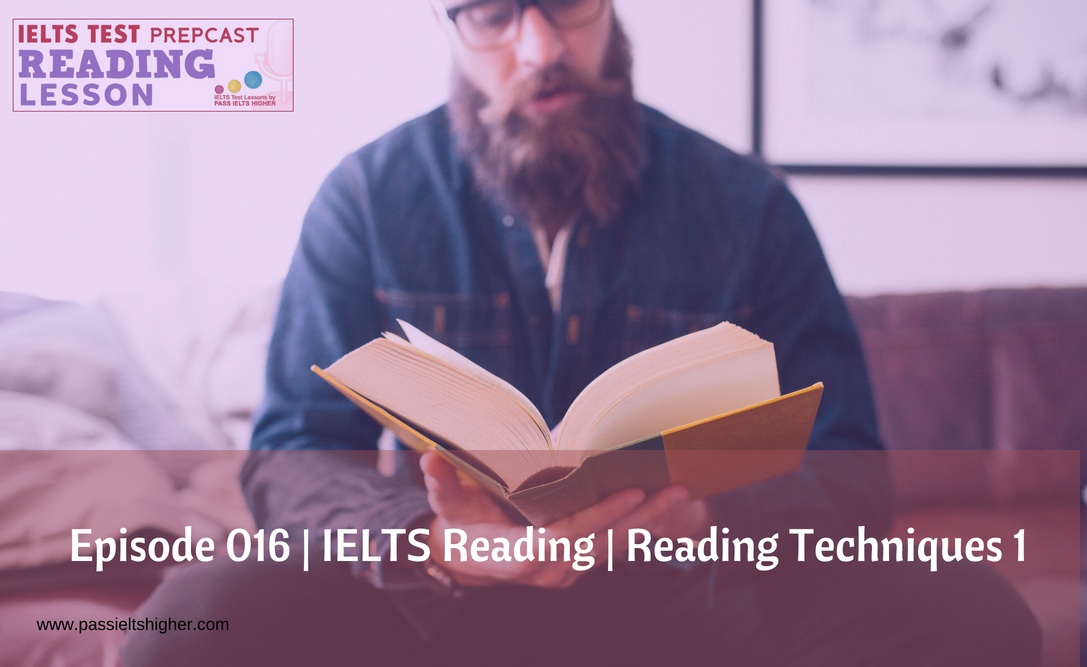

- Social:
- Link:
In this episode Andrea takes students through an IELTS Reading question from Cambridge IELTS 7 Practice Tests and explains why the question answers are correct.
This lesson presents a lower level of detail than covered in Episode 13 and will teach students the level of skill required by students when preparing for the IELTS Reading test.
Click here to join us and get access to our free downloadable Library of information.
Podcast Transcript
IELTS Test Prepcast Episode 16
IELTS Reading: Reading Techniques 1
I’m Steve Price. I’m the founder of the Pass IELTS Higher website, which was started in late 2010 and has been successfully helping students achieve higher band scores since. Andrea Price currently lives and works in London, teaching IELTS. She has been teaching the subject at home and abroad for over twenty years.
And now for today’s IELTS lesson.
Steve: Hello. Today we’re going to talk about IELTS reading. In particular we’re going to be talking about the question types that you get within the IELTS reading. And listeners will recall that in episode 13, we described approaches to the different types of reading question, whether you read the questions first or whether you read the passages first. And I’ve got with me today Andrea, who’s going to take us into a little bit more detail of the approaches to take with the question types that we have.
Andrea: Hi. So yes, we’re talking about IELTS reading today, and as Steve mentioned, there are more or less eleven or twelve kinds of questions. Today we’re going to look at one of the four types of questions, where I recommend that you read the passage first. This is only my recommendation. You don’t have to do what I say, but go away and try it, and I think you’ll see that your reading will—you’ll be able to read more quickly. This prepcast is linked to Cambridge 7 Practice Test, so you need to have that book with you.
So the reading approach I’m going to talk about today is where you read the passage first, and I recommend reading the passage first for four question types. These are matching headings to the paragraphs, locating information in the paragraphs, choosing from a list, and classification. Today I’m just looking at matching headings to the paragraphs. The students always find this quite difficult. And I’ve tried this and I actually find this quite difficult too. But hopefully, this will help you. And they also appear—matching headings to the paragraphs is quite a popular question in the IELTS reading exam. It usually appears in one of the passages, and sometimes in two.
Okay. Matching the heading to the paragraph. So we’ll talk about paragraph A. So I recommend that with the—you read the passage first or you read the passage paragraph by paragraph; otherwise, you won’t remember everything, obviously. So we’re going to look at the first paragraph today—sorry, we’re going to look at the first paragraph, paragraph A. For this example, you need to have Cambridge IELTS 7, the practice test.
Find test 1 in the book, passage 2. This text is called “Making Every Drop Count”. Read paragraph A and underline the keywords. So remember, those are the main ideas of the text. They’re usually the nouns and they might be the verbs. Summarize the paragraph in one sentence from the keywords. So here are the keywords I’ve underlined: “history”; “water”; “water from remote sources”; “sophisticated”; “Roman empire”; “supplied Rome”; “as much water per person as many parts”; “industrial world today”. My sentence summary of this is “The supply of water in Roman times is as good as in many parts of the industrial world today”. So what you’ll have to do is read the paragraph, underline the keywords, and be able to understand a little summary of the paragraph in your head. You could, while you’re practising, make notes at the side of each paragraph, but I think this actually takes quite a long time in the exam, so you just have to practice understanding a summary from your keywords.
Having done that, then you look at all the headings. So there are eleven headings here. Look at all the headings, one to eleven. Underline the keywords in each of the headings. While you’re doing this, you should hopefully realize quite quickly which heading belongs to your paragraph A. You ask yourself, which keywords that I have underlined from a heading match the keywords to paragraph A or my sentence summary of paragraph A? The answer is 11 because of the following matching of keywords in the passage and keywords in the heading or the paraphrases. So the keywords from heading 11 are “ancient water supplies”. The sentence summary of paragraph A is “history”, “water”, and “Roman times”. So we’ve got “history” and “Roman”, which means “ancient”, and “water” is “water”. So you know that heading 11 belongs to paragraph A. Be careful.
Every time they do matching headings to the paragraph, they always give you one example. In this reading passage, it’s paragraph B with heading 3, so that means, in the exam, you don’t need to read that for the matching headings. You can just go on to paragraph C. However, I have done a reason for the answer, just to let you know, and you get more practice.
Matching the heading to the paragraph B. Read paragraph B, underline the keywords, summarize the paragraph in one sentence from the keywords. So obviously, these are my instructions for every paragraph. I’m telling you now in detail so that hopefully, you practise more and more, and you’re just going to get quicker and quicker. So the keywords of paragraph B are “population explosion”, “nineteenth twentieth century”, “demand for water rose”, “food product”, “kept pace”, “soaring populations”, “expansion”, “irrigation systems”, “40 percent of the world’s food”. The sentence summary from this is “With the growth in population, more water was needed, and irrigation systems made it possible to produce 40 percent of the world’s food”. Then you look at the headings 1 to 11 again. Pull out the keywords. Which keywords from the heading match your paragraph keywords or your sentence summary? The answer is three because the keywords from the heading which match the keywords in paragraph B are “global challenge”, and keywords in the summary paragraph B are “40 percent of the world’s food”.
You repeat the process with paragraph C. Read paragraph C, underline the keywords, summarize the paragraph in one sentence from your keywords, and soon you’ll realize you just sort of get a summary in your head rather than writing out a sentence. “Half the world suffers”; “water service is inferior”, “lack of access to clean water”, “preventable water-related diseases”, “kill”, “ten to twenty thousand”. Then look at your headings 1 to 11 again. Pull out the keywords. Which keywords from the heading match your paragraph keywords or your sentence summary? The answer is 7 because keywords from the heading match keywords from the paragraph. And I’m telling you each time, and I’m repeating just so that this stays in your head. Obviously, you’re just going to get quicker and quicker. So the keywords from the heading 7 are “relevance in health”. The keywords from your summary paragraph C are “half the world suffers”, “preventable water-related diseases”, “kill”.
Again, you repeat the process. Read paragraph D, underline the keywords, summarize paragraph in one sentence. The keywords from paragraph D are “fish species”, “threatened”, “destroyed free-flowing river ecosystems”. Matching the headings, look at the headings 1 to 11 again. Look at the keywords. What keywords from the heading match your paragraph keywords? Heading 5 is correct because the keywords from the paragraph match the keywords from the heading. Heading 5, the keywords in heading 5 are “environmental effects”. The keywords from paragraph D are “fish species”, “threatened”, “destroyed free-flowing river ecosystems”.
Repeat the procedure in paragraph E. Underline the keywords. Summarize the paragraph. The keywords are “resource planners”, “change”, “some water experts”, “demanding”, “existing infrastructure used in smarter ways”. Look at the headings 1 to 11 again. Look at the keywords. Heading 1 is correct because the keywords in the heading match the keywords in the paragraph. Keywords in the heading are “scientist”, “revision of policy”. The keywords in the paragraph are “water experts”, so these are the scientists, and “infrastructure used in smarter ways”—that’s a revision of the policy.
Repeat the process for paragraph F. Underline the keywords. The keywords are “unexpectedly”, “demand for water”, “not rising as rapidly as predicted”. Look at the headings 1 to 11. Look at the keywords. Which keywords match the keywords in the paragraph? Heading 9 is correct because the keywords in the heading match the keywords in paragraph F. The keywords are, in heading 9, “surprising”, “downward trend”, “demand for water”. The keywords from paragraph F are “unexpectedly”, so obviously that links to “surprising”, “demand for water not rising”, and then they say “downward trend” for the “water”.
Again, look at paragraph G. Underline the keywords. What keywords explain this: “People figured how to use water more efficiently”. Look at the headings 1 to 11. Look at the keywords. Heading 2 is correct because the keywords in the heading match the keywords in the paragraph. Keywords from heading 2: “explanation”, “reduced water use”. Keywords from paragraph G are “explains this”—obviously links to explanation—“People figured how to use water more efficiently”, and that’s “reduced water”.
And finally, read paragraph H, keywords. The keywords are “Projects must be built to higher specifications”. Look at headings 1 to 11. Look at the keywords. Heading 10 is correct because the keywords in the heading match keywords in paragraph 8. Keywords from heading 10 are “need”, “raise standards”. Keywords from paragraph H are “projects”, “must be built”, “higher specifications”. So “higher specifications”, “raised standards”. And remember that not all the headings will match all the paragraphs. Obviously, you select the headings to match the paragraphs you’ve got. And that’s the end of the podcast to tell you how to, that really tells you to read the passage first when you want to match the headings to the paragraphs. What I didn’t highlight, obviously, was that you’re using skimming skills here to read them quickly, and then you’re scanning as well to find the keywords, really, when you go backwards and forwards.
Steve: Okay. Well, I think this has been a very useful lesson for the students, in particular because they can go away, they go and dig up a copy of, or borrow a copy of, Cambridge IELTS 7 practice tests, and they can go to the test 1 passage, to “Making Every Drop Count”, and then they can, in conjunction with the lesson, they can go through each of the questions and they can understand your approach to each one of those questions. And in that respect, they can gain an understanding of how you, as a teacher, would be looking at those questions and how you would go about answering them. So hopefully they, if they spend a bit of time, if they concentrate on it, then they should be able to get a far better an understanding of how this sort of questions is attacked. And over time, if they practise a lot, then they should become better and better and therefore faster at doing this.
Andrea: Yes, and I agree with you. You’ve got to go away and practise. I can give you the tips or the skills, but you need to practise to be able to pull out keywords efficiently and then to make yourself able to do it more quickly.
Steve: Okay. And I know you’ve spoken about this before, but how would a student recognize keywords?
Andrea: Well, keywords, really—obviously, they’re the most important ideas in the paragraph, and they’re usually nouns. So they’re usually names of people, maybe. Or the general ideas so they’re verbs, or verbs and prepositions or collocations.
Steve: Okay. And are they expected to xxx use paraphrasing or synonymous expressions to come to the answers?
Andrea: Yes, usually yes. So whatever keywords are in the paragraph, they will match words that are in the headings, but obviously, they’re not going to be the same words. They’re going to be synonyms. And I think, obviously, the more you do it, the better you’re going to get at it. And already you’re, remember, you’re quite, you’re—the people using the podcasts have already got quite a high level of English, so they should be quite efficient.
Steve: Okay. In fact, that brings me to a number of questions that we’ve had. We’ve had a few comments where people are saying that we do tend to talk relatively quickly compared with other podcasts, where people are a little bit more, perhaps a bit ponderous in their way of speaking. I know you and I have discussed this, but why don’t we just let the listeners know why it is we talk at our normal way, normal rate of speaking.
Andrea: Well, obviously, that’s really good for your listening skills. You’re going to have to understand, when you go into the IELTS exam, you’re going to have to understand English people or native speakers speaking at their normal rate, and for that reason, I speak—in fact, I do speak quite slowly, I think, for a native speaker because I am a teacher. But if you think I’m speaking quite quickly, it’s because I want to improve your listening skills, and you’re—if people are speaking too slowly all the time, that’s not natural. I’m speaking to you in a natural way, and hopefully, you’re going to start understanding me and other people more quickly or in a better way.
Steve: Okay. So what we’re saying there, I guess, is that if you are aiming for band scores 7, 8, and the nirvana of 9, then you really should be able to understand people like us native speakers speaking at the rate that we’re speaking.
Andrea: Yes. And I think even it’s not about IELTS. Of course, that’s why you’re in a country where people actually speak English, so that you can start to understand English naturally, and that’s what I want to help you to do.
Steve: Okay. We sure continued to do that. Okay, so from a point of view of what we were trying to achieve today with the IELTS reading, I think we’ve covered everything. There’s clearly a lot for the students to go away and to practise and think about. We would be very receptive to any questions or any comments that the students listening to the podcasts have, and we would welcome those. Please navigate your way to the episode blog post, the page in which the episode appears on the website at www.ieltstesprepcast.com, and leave any comments or questions that you have there, and we’ll be sure to address them. But until next time, thank you very much.
Andrea: Bye-bye.
If you enjoyed this free IELTS Test Prepcast, please show us your support and appreciation by heading over to ieltstestPrepcast.com and clicking the “subscribe on iTunes” button at the top of the page. This will shoot you over to iTunes, where you can leave a rating and review.
You’ve been listening to the IELTS Test Prepcast, which provides three free IELTS lessons for candidates aiming for IELTS band score 7, 8, or 9. Subscribe to this prepcast in iTunes, or download it from our website, www.passieltshigher.com.

Leave a Reply